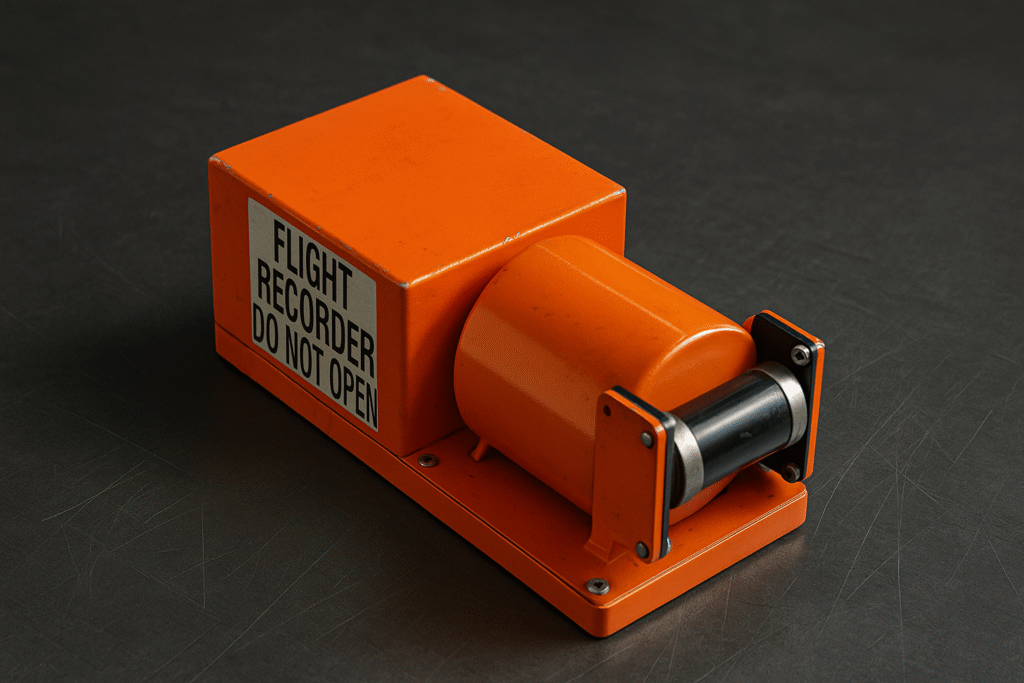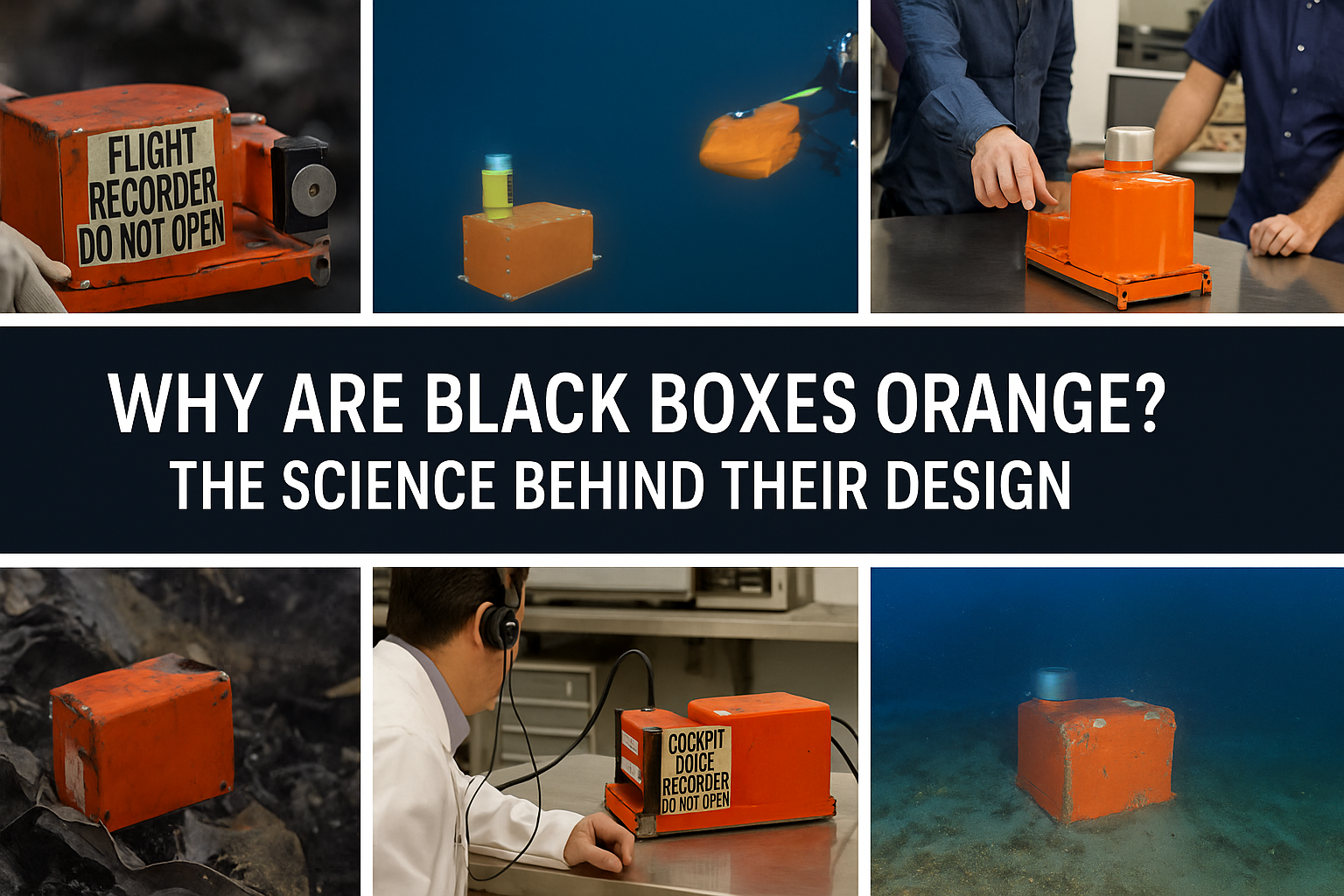Why Are Black Boxes Orange? The Science Behind Their Design

1. Introduction
When I first walked into an aircraft investigation hangar a decade ago, I expected to see metal and machines. Instead, I saw something far more poignant: a bright orange box resting amid twisted wreckage. In that moment, the color struck me—not because it was loud, but because it was hopeful. It said, “I’m here. I’m telling your story.”
That scene marked the beginning of my deep respect for what we casually call the black box airplane. It’s more than a data recorder—it’s a guardian of memory, a silent witness to pilots’ last actions and machines’ final breaths. In the crash aftermath, its visibility, durability, and voice matter more than anything.
In this blog, let’s walk through the why and how behind its striking color, its battle-tested build, and the raw humanity embedded in its design.
2. Origins Rooted in Human Loss
In the 1950s, dozens of mysterious plane crashes left families without answers. Among them was the personal tragedy of Dr. David Warren, whose father died when one of the earliest commercial jets plunged. Warren imagined a device that would speak for the silent—capturing essential flight data and pilots’ final discussions.
So he built it. And it worked—though early prototypes were met with resistance. Pilots worried, and airlines hesitated. Yet families demanded transparency, and within a few years, these devices became mandatory, symbolizing aviation’s commitment to accountability and learning.
3. Why Bright Orange?
3.1 Contrast Counts
In the chaos of a crash site—whether in dense forest, blazing fire, or deep sea—visibility determines search success. Surveys and real-world recoveries have consistently shown that international orange is the most visible color amid debris, water, or charred wreckage.
3.2 Psychological Impact
Imagine slogging through icy water or jagged terrain at dawn. Spotting a flash of orange can reignite determination and focus. That visceral reaction—alertness, hope, direction—that’s the power of intuitive color choice. It reminds us: human design isn’t just about functionality—it taps into our instincts.
4. Dual Functions: FDR and CVR
The “black box” is actually two recorders in one:
- Flight Data Recorder (FDR) logs altitude, speed, engine performance, controls positions—even changes in flight direction.
- I’ve always believed that the Cockpit Voice Recorder (CVR) doesn’t just record what was said — it captures what was felt. Inside that pressurized room at 35,000 feet, every sound has a story. A clipped instruction. The whir of a switch. The shift in a pilot’s tone when something feels off. These aren’t just recordings — they’re traces of humanity in the most high-stakes environment imaginable. In those final moments, when time seems to both slow down and disappear, the CVR preserves not just the facts, but the emotions behind them — fear, focus, frustration, hope. For investigators, listening to a CVR is never just technical. It’s personal, because you’re hearing the last pages of someone’s story — not read aloud, but lived in real time.
5. Engineering That Mourns & Protects
The FDR/CVR sits within a fortress built to resist:
- Impact forces up to 3,600 Gs—equivalent to a car hitting a wall at 500 mph.
- Temperatures exceeding 1,100 °C for up to an hour.
- Ocean depths over 6 km, under crushing pressure.
Inside, solid-state memory boards are encased, while thermal insulation guards against fire. Outside, a locator beacon activates in water, pinging for up to 30 days. Every component is engineered to preserve the truth—and with it, make sense of tragedy.
6. Stories Where Orange Made a Difference
- Air France 447 (2009): Recovered from 4 km beneath the Atlantic after nearly two years. The beacon and unmistakable orange shell guided the searchers.
- Germanwings 9525 (2015): The CVR revealed the pilot’s final words and silence before impact—prompting global conversations on cockpit protocols.
- MH370 (2014): Though still missing, its search triggered a global push toward real-time flight data streaming, a future where physical recorders might be complemented by live backups.
Each case shows that orange isn’t a cosmetic choice—it’s purposeful, emotional, and lifesaving.
7. Beyond Technology: Human Emotion in Design
When I spoke with engineers, many confessed a bittersweet pride. Their work ensures that, in disaster, someone hears the last moments. Investigators often describe a solemn hush when reviewing CVR audio—no dry data, just human voices: calm, panicked, determined. I’ve witnessed tears as a recorder reveals a final “I’ve got it” or a solemn prayer between pilots.
Policymakers, too, feel its weight. Just a decade ago, they insisted on satellite ping extension and tougher tests. All because they’ve felt the sting of loss and the kindness of clarity.
8. The Future: Orange at the Intersection of Innovation
The future blends tradition with innovation:
- Cloud streaming & satellite backup: Data continuously sent to ground stations—so nothing disappears.
- Longer beacon life: New batteries promise pings for 90 days or more.
- Tougher memory modules: Designed to survive deeper sea pressures and hotter fires.
Yet in every scenario, one thing remains: the box itself remains orange. Because until the world transitions fully to live-streamed flight records, that bright color remains our lifeline in the aftermath.
9. Conclusion
A crash site—regardless of location—starts with fear, confusion, and grief. Amid that chaos, a flash of orange offers clarity. It doesn’t just catch the eye—it reassures hearts.
This is why the so-called black box is bright orange: not for decoration, but for human need—visibility in darkness, reliability in disaster, and emotional comfort to those left behind. In every curve and seal, humanity is woven into metal. In that rugged shell, there’s not just data—but truth, closure, and maybe, a measure of peace.
So next time you see that orange box, remember: it’s not just engineering. It’s empathy in aluminum and circuits, a guardian that survives to ensure every final moment is heard.
FAQ 1: If the black box is so important, why isn’t it easier to find?
That’s a question that haunts many of us — especially when a plane goes down in a vast ocean or thick jungle. The truth is, even with the black box painted bright orange and fitted with a beacon, nature doesn’t make recovery easy. Wreckage scatters, the sea swallows fast, and terrain can bury the clues. Still, engineers have done everything humanly possible to help it survive. But sometimes… even the best design needs more than engineering. It needs time, weather cooperation, and a bit of grace from the environment.
FAQ 2: Do black boxes record the pilot’s last words?
Yes… and that’s the part many investigators say they never get used to. The Cockpit Voice Recorder (CVR) doesn’t just record data — it captures real people, in real moments. Sometimes it’s technical chatter. Sometimes it’s calm professionalism. And sometimes, it’s raw emotion — panic, courage, heartbreak. These recordings are private, powerful, and treated with a level of reverence you’d expect from someone holding a person’s final journal. For those who listen to them, it’s never just a job. It’s personal.
FAQ 3: Why hasn’t technology made black boxes obsolete yet?
It’s a fair question. In an age where our phones back up to the cloud instantly, why aren’t planes streaming everything in real-time? Well, some are starting to. But full global coverage, especially over oceans and remote regions, is still being developed. Plus, there’s something about holding the actual device — the physical record, battle-worn and burned, yet still speaking — that matters. Survivability. Reliability. And above all, proof. Until live data becomes truly universal, that orange box remains irreplaceable.
FAQ 4: Can black box data ever be hidden or erased?
Technically, no — not easily. Black boxes are designed to protect the truth, not manipulate it. The memory chips are sealed inside crash-resistant shells, far from the reach of tampering hands. But here’s what matters more: in aviation, integrity is sacred. Investigators work independently. Families demand answers. Pilots want the truth out. If anything is missing, people notice. And in most cases, the black box becomes the loudest and most honest voice in the room — especially when others stay silent.
FAQ 5: Who listens to the CVR after a crash? Isn’t it too personal?
Yes, it’s deeply personal — and that’s why it’s treated with immense respect. Only authorized investigators, often from national aviation safety boards (like NTSB or DGCA), access the audio. Transcripts may be released in official reports, but audio clips are almost never shared publicly. For investigators, listening to a CVR is one of the most emotional parts of the job — it’s not just about data; it’s about honoring voices that can no longer speak for themselves.


